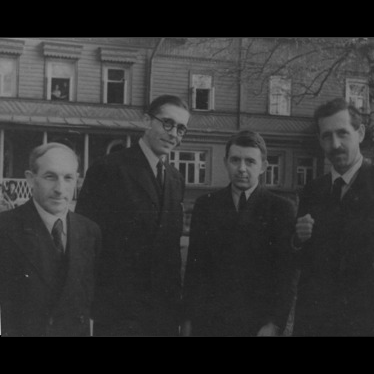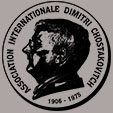Catégorie : Non classé

William KAPELL: III Concerts n° 21 – 37 ( SEPTEMBER 17 – OCTOBER 22): ADELAIDE, BENDIGO, SHEPPARTON, MELBOURNE, CANBERRA, SYDNEY, ALBURY, HORSHAM, GEELONG
TRIBUTE TO WILLIAM KAPELL: 70 years ago, William Kapell made his second Tour in Australia. The 37 concerts are listed for the first time. To end with, here are the programs and reviews of the last 17 concerts.
21,22 & 23- September 17, 18, 19 ADELAIDE TOWN HALL
PROKOFIEV Concerto n°3 South Australian SO (Adelaide SO) dir: Joseph POST [Eugene GOOSSENS cancelled]
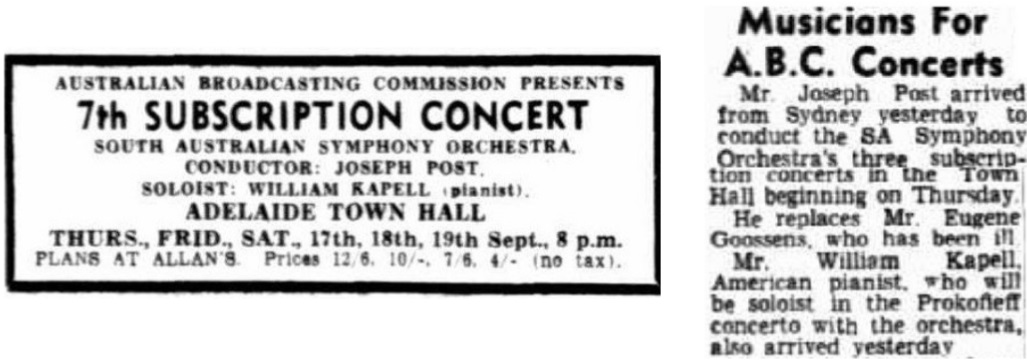
News Adelaide (September 18): ‘For sheer virtuosity, pride of place must be given to the visiting artist, William Kapell. who played the Prokofleff Concerto No. 3 in C Major, Op.26. He appears to have all the qualities that go to make a pianist great. His marvellous clarity, vital strength, and brilliant technique will be long remembered. After a rather uncertain opening by the strings, the orchestra gave most satisfactory support in bringing out the characteristics of this dynamic work with its changing mood and rhythmic force’. Constance Pether.
The Mail Adelaide (September 19): ‘William Kapell took great pleasure in the playing of the Prokofiev Concerto in C at the Subscription Concerts this week and managed to communicate a considerable amount of this pleasure to his audience. This music, much of which is acrid and percussive, has something startling on every page. In fact, it is packed with surprises, and only a pianist with Kapell’s tremendous technique can make it sound convincing. Joseph Post was the conductor, and much of the success of this work was due to his alert mind and clear beat. James Govenlock

Kapell practicing in Adelaide
24- September 22 BENDIGO CIVIC HALL
25- September 23 SHEPPARTON STAR THEATRE
SCARLATTI 4 Sonatas – [cancelled: BEETHOVEN Sonata n°23 Op.57] – MENDELSSOHN 4 Songs Without Words – CHOPIN Barcarolle Nocturne Op.55 Scherzo n°1 Op.20 Waltz in E Flat
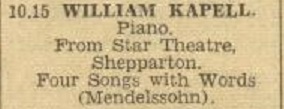
Broadcast at 10.15 p.m.
Kapell was scheduled to play Beethoven’s Sonata n°23 Op. 57 on September 23 (Shepparton) and October 17 (Horsham). He had never played the work before, and he chose not to try it in the bigeest cities. However, he cancelled it at the last minute, because ‘the work wasn’t ready’. For this reason, we do not know what program he performed. Surprisingly, only the works by Mendelssohn were scheduled for broadcast, later in the evening (Radio Stations 2FC-NA and AR).
On September 24, Kapell’s wife, Anna Lou took a plane at the Sydney Airport to fly back to New-York.
26, 27, 28 & 29 – MELBOURNE TOWN HALL VICTORIAN SO dir: Sir Bernard HEINZE (1894 – 1982)
September 26, 28 BRAHMS Concerto n°1 Op.15 (‘Red Program’)
September 30, October 1* *RACHMANINOV Concerto n°3 OP.30 (‘Blue Program’)
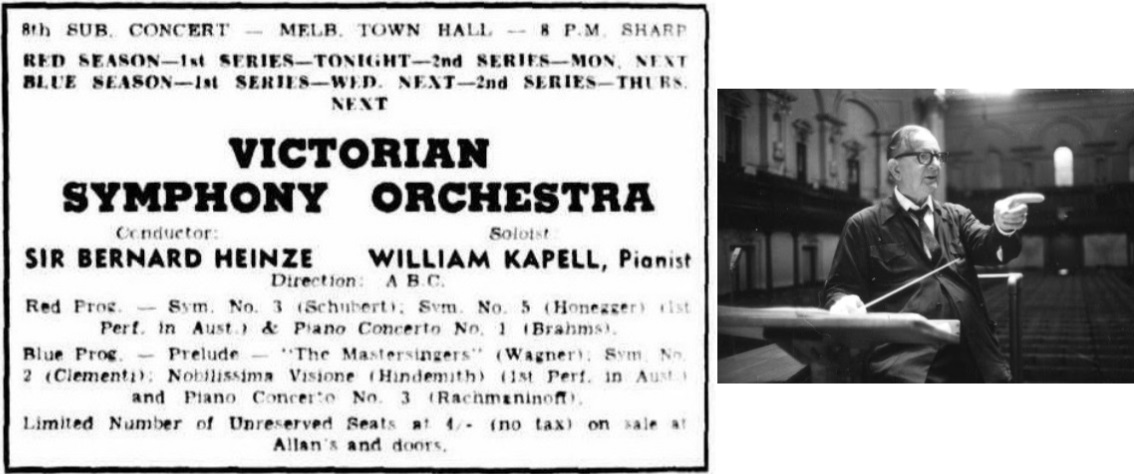
Each program included a First Performance in Australia: Honegger’s Fifth Symphony and Hindemith’s Nobilissima Visione respectively, but none of them was broadcast by either of the three Radio stations (2BL-2NC,AR, and 2FC-NA).

The Argus (September 28): ‘Interpretation of great music is a spiritual adventure for William Kapell. To share his discoveries with the public is, to his mind, both an obligation and a privilege. This rare approach to a job too often affected by box office considerations ensured a superb performance of the Brahms D Minor Concerto on Saturday night. To this work, compact of heroic energy and human compassion, Kapell gave all he had of intellect, imagination, and physical daring. As conductor, Sir Bernard Heinze watched over the gifted young American pianist as if he were his own son, and the orchestra gave wholehearted support’. Biddy Allen
The Age (October 1): ‘William Kapell, a dynamic young American pianist, showed last night that he is iust the man to rescue Rachmaninoff from his ranking as a composer of respectable obscurity. With the Victorian Symphony orchestra, under Sir Bernard Heinze, Mr. Kapell played Rachmaninoff’s third piano concerto with a fierce intensity that indicated his belief in this composer’s greatness. Although suffering from what appeared to be a heavy cold, the soloist succeeded in firing both orchestra and audience with his impassioned approach to the work and received an ovation at the conclusion of the vigorous final movement. Sir Bernard Heinze’s direction of the orchestra maintained a spirited level throughout the concerto, and the massive climaxes were always well timed and in good control’.
LAST EIGHT CONCERTS:
30- October 03 CANBERRA ALBERT HALL Program n°1
BACH Suite BWV818 – MOUSSORGSKY Pictures at an Exhibition – MOZART Sonata K.330 – CHOPIN Sonata n°2 Op.35
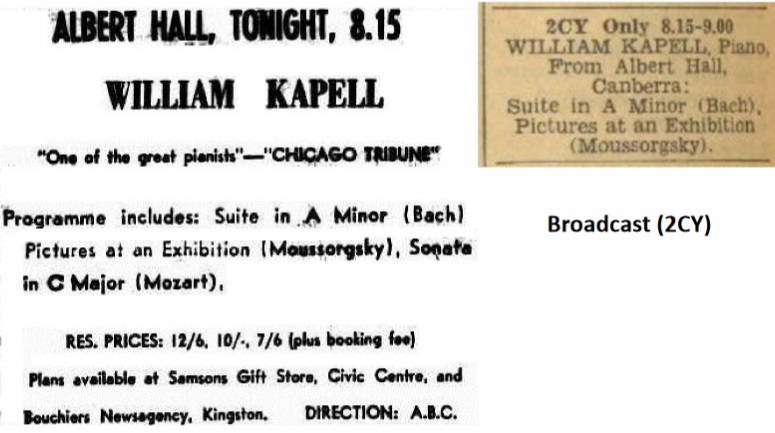
The Canberra Times (October 5): ‘American pianist William Kapell presented a recital of profound artistry at the Albert Hall on Saturday night. The concert, the last in the A.B.C. celebrity series for ladies was attended by about 700. Pianist evoked prolonged applause, even stamping after one item. He played three encores with the same deft skill that had aroused this enthusiastic reception. His programme comprised four compositions: the Suite in A minor by Bach, the Sonata in C Major by Mozart, the Sonata in B flat minor by Chopin, and the vividly descriptive « Pictures at an Exhibition, by Moussorgsky. All suited his direct approach to music; a chaste almost impersonal style that without affectation extracted the effect from composition through infinite variations in tempo and loving strength. He distilled a living music that throbbed in cascades of crisp, pure sound through the hall. His Bach, with its simple patterns of indigenous colour, and his Mozart, were played in a composed, articulate manner, with every note clearly in place and expressed in harmonious form. In contrast his penetrative interpretation of Mussorgsky’s « Pictures » was powerful, though dispassionate… Kapell’s « Gnomes » were mischievous, unpredictable little busy bodies, scrambling feverishly from point to point; his Tuileries, the squabbling of children at play, sometimes in fun, sometimes peevishly. The « Market Place » had an undertone of urgency that increased as the day drew to a close; there was the battle of bartering, the rush and bustle of trade all in place on the artist’s canvas. Samuel Goldenberg and Schmuyle were powerful caricatures. Chopin’s sonata was equally interesting, for its variety of moods and the strength of its themes. It was a work of exquisite melody, and in almost the same breath of passion. The majestic funeral march continued these qualities behind which the finale, ‘the agitated whirring triplets’, became so much the rumbling of the thunder in the distance’.
Daily Examiner (December 23): ‘Last October, 25-year-old pianist Leone Stredwick and her husband, journalist Hal Myers, entertained William Kapell after he had given a piano recital in Canberra. In his usual tireless fashion, Kapell went to the piano and began to play, turned up in the process one of the Mendelssohn « Songs Without Words, » which so fired Leone that she chose one of the same group for her Sydney A.B.C. studio recital on Tuesday. The end of the Kapell episode was that he dragged out some duet books and both husband and wife accompanied him till four in the morning. » One of the most precious memories of my life » said Leone. What struck me was that he was a man who liked simple music-making without fuss and bother’.
31, 32, 33 & 34 SYDNEY TOWN HALL Sysney SO dir: Joseph POST [cancellation GOOSSENS]
October 07, 08 BRAHMS Concerto n°1 Op.15
October 10*, 12 PROKOFIEV Concerto n°3
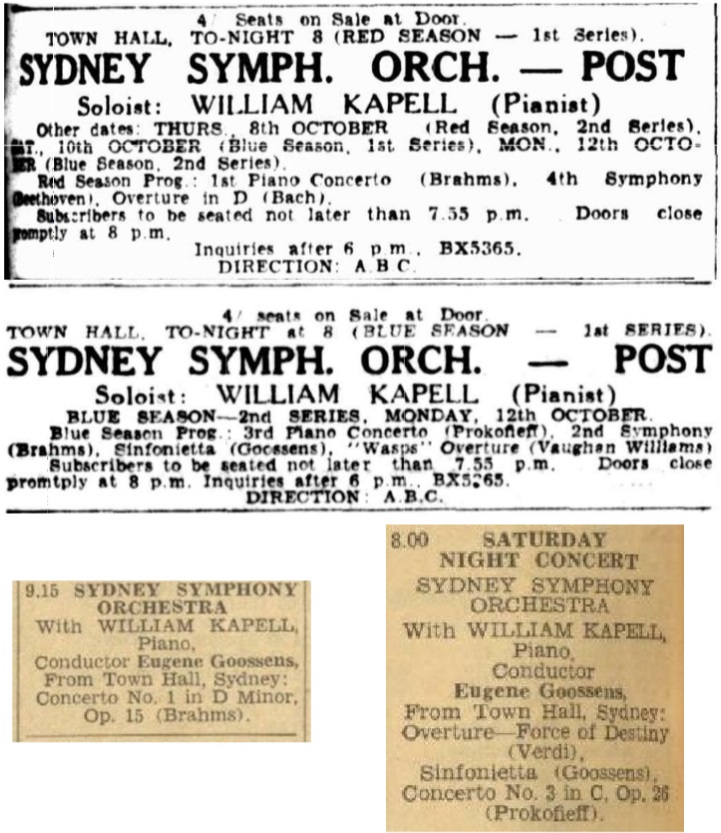
Eugene Goossens cancelled again because he was ill (back injury), and he was replaced at the last minute by Joseph Post. The broadcasts of October 7 (Brahms) at 9.15 p.m. (2FC-NA) and October 10 (Prokofiev) at 8.00 p.m. (2BL-NC) have been announced in ABC Weekly (October 3), with of course Goossens as a conductor.
The Sydney Morning Herald (October 8): ‘…The playing of the Sydney Symphony Orchestra under Joseph Post was generally disappointing. It was the soloist, William Kapell, who provided the vividly clear-cut performance of the evening in the solo part of the first Brahms piano concerto. Kapell’s vigorously disciplined attack on the first solo passage of the Brahms was the memorable event of the concert. There is a great deal in this concerto that suits him admirably particularly in the jagged emphatic outbursts of the first movement and the twinkling passages of figuration that come towards the end of the Rondo. He does not capture the tenderness and humanity of Brahms with quite such distinction: the slow movement and the lyical episodes of the first, were more memorable for their clarity than for their warmth. M.L.
The Sun (October 8): ‘The open-hearted geniality of Beethoven’s fourth symphony and the electric nervous vitality of William Kapell’s performance of the Brahms B fiat major piano concerto provided two points of strong contrast in the Town Hall concert by the Sydney Symphony Orchestra last night. Kapell’s reading of the Brahms was full of defiance and impetuosity and superb technique’. John Moses
The Sydney Morning Herald (October 12): ‘ William Kapell was soloist in the Piano Concerto n°3 of Prokofiev. Here is a work that does not make demands on warmth of feeling and sensitivity of response and it goes without saying that it was crisp and authoritative under Kapell’s fingers. But somehow one expected more voltage from the soloist, and more mystery from the orchestra in such passages as the stealthy opening of the slow movement’. M.L.
Catholic Weekly Sydney (October 15): ‘The Prokofiev Concerto n°3, played by William Kapell, brought some capital co-operation between conductor and pianist. Actually, this concerto calls for an extraordinary amount of. hard work from the pianist without any compensating sense of reward, particularly in the first movement, which is a powerhouse of interminable energy, calling for the utmost dexterity and agility upon the part of the soloist. Kapell was magnificent here, and in the sly, mocking humor of the variations which make up the second movement, his magnificence was matched by the white hot accompaniment of the orchestra’. R.J.R.
Yass Tribune Courier (November 5, 1953):’ At his last concert in the Sydney Town Hall, one of that city’s most ardent music supporters, Lady Plowman, said:’ I fear that young man is not long for this world. He is burning himself out, practicing until two or three o’clock in the morning, and smoking up to 200 cigarettes a day. No one can continue like that ‘’.
Legally, the Australian Broadcasting Commission (ABC) was not allowed to keep recordings of broadcast performances. The concerts (or rather parts of the them) were broadcast live, or recorded on EMI tape recorders and broadcast later in the evening, but then, after the broadcast, the tapes had to be erased ‘in the interets of the artist’. However, a tape of the Kapell performance of the Prokofiev Concerto n°3 from the October 10 concert conducted by Joseph Post, Kapell’s last performance with an orchestra, surfaced later, and was sent to RCA for evaluation. But, RCA, having already published a Kapell recording of this work with Antal Dorati, was not interested and sent the tape back, believe it or not, without having made a copy thereof, and this recording is supposed to have been lost forever.
35- October 14 ALBURY
36- October 17 HORSHAM TOWN HALL
[Original Program: SCARLATTI 4 Sonatas, BEETHOVEN Sonata n°23 Op.57,MENDELSSOHN 4 Songs Without Words, CHOPIN Barcarolle Nocturne Op.55 Scherzo n°1 Op.20 Waltz in E Flat]
SCARLATTI 4 Sonatas – CHOPIN Sonata n°3 Op.58 – SCHUBERT 3 Impromptus – MENDELSSOHN 3 Songs Without Words – LISZT Hungarian Rhapsody n°11
Encores: Cuban Folksong (arr: ITURBI);MOZART Rondo alla Turca; DEBUSSY Clair de Lune
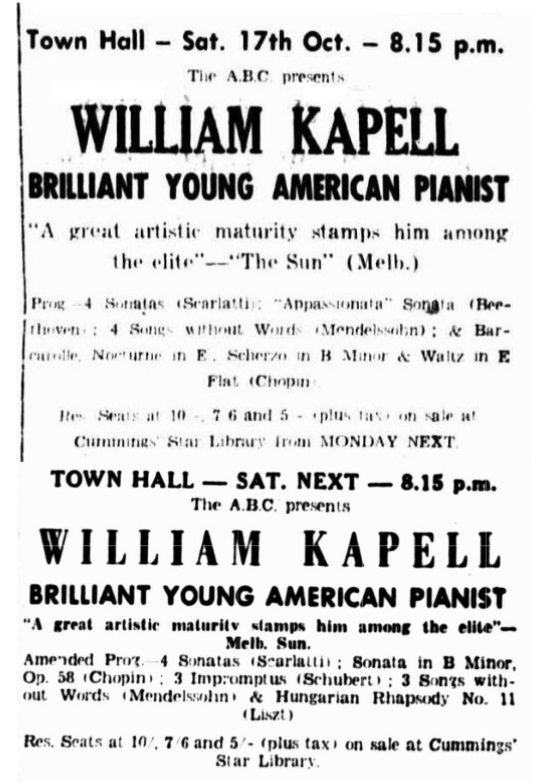
Kapell decided to cancel again the performance of the Beethoven Sonata n° 23 Op.57 which means that it was not played at all during the tour. Since the original program was the same as for the recital in Shepparton (September 23), maybe he played the same amended program in Shepparton.
Horsham Times (October 19): ‘With a combination of great technical skill and superb interpretation, American pianist William Kapell delighted a large audience at the Horsham Town Hall on Saturday night. His great desire to give every piece the interpretation intended by the composer was obvious although the program rather restricted his energetic style. Kapell certainly did not play as one inspired but this did not detract from his technique. He gave the impression that he was fighting himself and the piano to catch the spirit of the piece. To watch him at the piano, was as interesting as listening to the music. The impression was not one of listening to a great pianist produce music so much as seeing a great pianist fight endlessly for the brilliance which it offered. It was by no means a losing battle and the fight was a worthy one. The fact that such music could be produced was a tribute to Kapell’s concentration and artistic honesty. Too many artists today are inclined to pass off their own interpretations, because the process of trying to catch the composer’s intentions requires thought and effort. Any pianist who is technically good and then, above that, tries to master the original sentiments of the music must necessarily enter a higher class. By his great concentration, Kapell has raised himself to the class but, unhappily, his nervous tension has also been raised far above normal. His personal style is one of great energy, but Saturday night’s program did not cater for it. His handling of the four Sonatas by Scarlatti was good and the audience had ample opportunilty to appreciate his faultless technique. His left hand work in these, and in the following pieces, was outstanding. He seemed more at home with Scarlatti than he did with Chopin’s Sonata n°3 in B Minor. In this his technical skill was again obvious. Kapell showed his adaptibiilty in the handling of Schubert’s Three Impromptus and Mendelssohn’s Three Songs Without Words. The fineness of his touch was particularly pleasing in the three songs and the wealth of melody made it probably the most popular item on the program. The last item on the program was the Hungarian Rhapsody no. 11 by Liszt. A more colorful piece, it was well handled and Kapell’s combined technique and fervor made it memorable. As encores, he played a Cuban Folksong, arranged by Jose Iturbi, Turkish Rondo by Mozart and one of the most beautiful interpretations of Debussy’s Clair de Lune it would be possible to hear anywhere’.
Kapell gave a last interview to Eunice Gardiner (Daily Telegraph). It was published on October 18 under the title ‘The madhatter critics have driven me away’ swearing that when he leaves Australia following week, it will be forever. His bitter protest was directed almost wholly against Mr. Browne of the Sydney Morning Herald. The paradox is that he never had such problems with US music critics, even the toughest of them. For example, he was praised by Claudia Cassidy (Chicago).
37- October 22 GEELONG PLAZA THEATRE
MOZART Sonata K.331 – *CHOPIN Sonata n°2 Op.35 – DEBUSSY Suite Bergamasque – SCHUBERT 2 Impromptus – LISZT Hungarian Rhapsody n°11
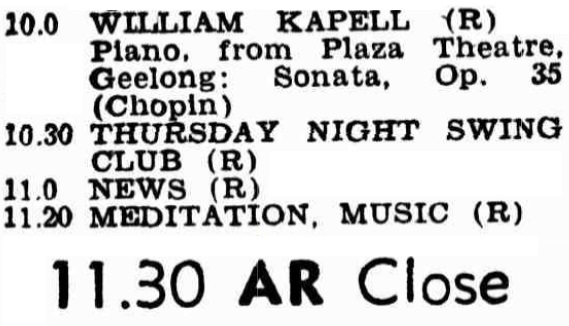
The concert started at 8.15 p.m. The Chopin Sonata n°2 was broadcast at 10 p.m. by AR and 3AR (Melbourne) Radio stations, which means it was recorded on tape and broadcast just after the end of the concert. Next morning, Kapell went to the ABC studios in Melbourne to be given a tape of this performance. ‘I’ve never played like that before’, he said. But even he could not obtain it. Without knowing, Roy Preston saved the day by recording the broadcast of the Sonata on an acetate disc (16’’, 33rpm) that was used later for the LP and CD Editions of this now legendary performance.
Kapell had to wait until October 28 to board the fateful plane named ‘Resolution’ of the Australian airline BCPA.



William KAPELL: II Concerts n° 15-20 (AUGUST 29 – SEPTEMBER 12)
SYDNEY, NEWCASTLE, MAITLAND
TRIBUTE TO WILLIAM KAPELL: 70 years ago, William Kapell made his second Tour in Australia. The 37 concerts are listed for the first time. Here are the programs and reviews of concerts n°15 to 20.
On August 27, the Executive Committee of the Sydney SO arranged a reception at the Royal Empire Society for visiting pianist William Kapell. On the picture below, he is talking with Mrs. A.H. Chartres, Secretary of the Committee.
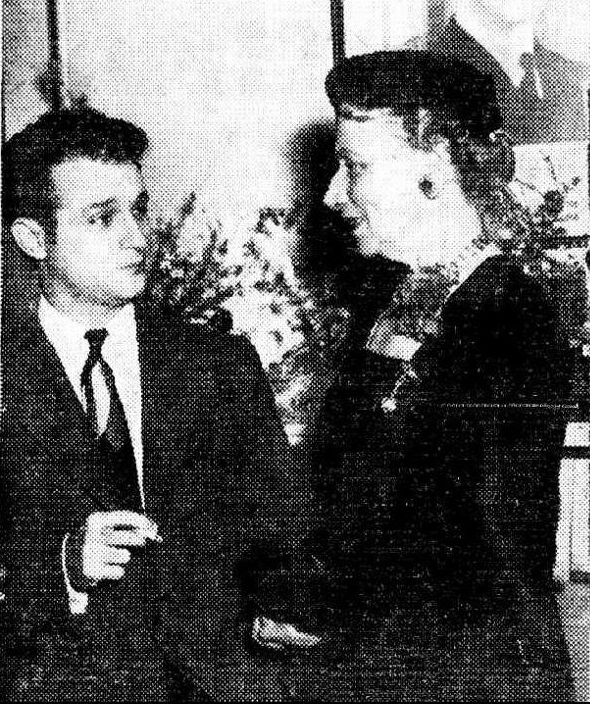
But, on August 29, the day of Kapell’s first concert in Sydney, he was ‘greeted’ by an article entitled ‘No Fancy Dress Mozart, Please’, published in ‘The Sydney Morning Herald’ under the name of Lindsey Browne, and aiming mainly at telling Kapell how he should play Mozart. Another negative article came out the next day. Kapell’s interview for the ‘Sunday Herald’ was published on August 30 under the title ‘The Deceptive Manner of William Kapell ’.
15- August 29 SYDNEY TOWN HALL SYDNEY SO dir: Eugene GOOSSENS (1893 – 1962)
RACHMANINOV Concerto n°3 – MOZART Concerto n°17 K.453

Announcement of the concert / Broadcast of the 1st part of the concert
The Sydney Morning Herald (August 31):’The American pianist, William Kapell, was pleasant and interesting company during the two concertos which he played at the Town Hall on Saturday with lhe Sydney Symphony Orchestra under Eugene Goossens. If it was not an occasion for highly memorable experiences, there was yet bountiful evidence of efficient and thoughtful craftsmanship in Mr. Kapell’s well reasoned approach to the concertos by Rachmaninoff (No. 3) and Mozart (No. 17 K453), and both were cordially applauded. The Mozart was the finer achievement. In the florid and rhetorical Rachmaninoff work, Mr. Kapell offered an interesting new point of view, without making a wholly convincing case for it. He seemed determined from the start to have no truck with the full-blown romance that the Olympians find in this airless, oppressive work. There was to be no « ham. » Right from the opening melody, which he played with coaxing modesty, to be overheard rather than heard, he chose the way of restraint and balance and that, of course, was not always to the advantage of a composer whose habit is to lay the colours on thick. In the gentlest lyrical episodes, Mr. Kapell had a poet’s way of bringing an exquisite quietude to the music; elsewhere, often, his Rachmaninoff was unduly lean and athletic. It was a musicianly idea to reserve the big display of thunder and explosions until the final movement, but even here, in the stockpiling of great sonorities, and the cascading filigree, Mr.Kapell gave an impression of vitality and efficiency, rather than of brilliant romantic colour. The Mozart performance was fluent, limpid and full of character, with barely a trace of the neuter metronomics that kill Mozart lt was not perhaps Mozart played to transport every audience to realms of light, but the quality of both the humour and the tragedy was unmistakable. The pianist’s absorption in the feeling of the slow movement, with strings expressing themselves in sudden dark downstrokes of pain, and his wit in the ingenious dialogues between piano and orchestra in the finale produced some admirable music’. Lindsey Browne
The Sun (August 31): ‘After an absence of eight years, American pianist William Kapeli greeted a large audience at a Town Hall concert on Saturday night with some uncommonly attractive playing in each of two concertos—one of them as common by nature as the other is attractive. The concertos were Rachmaninoff’s. the third in D minor, and Mozart’s, in G major K.453. Both were received with equal warmth by a large audience. Whether this was due to an increasing sophistication in musical taste in Sydney or the fact that Kapell played them might provide fruitful argument for idealists on the one hand and cynics on the other. At all accounts, it was a rare delight to hear a Mozart concerto played with the aristocratic polish and well-bred charm which Kapell brought to the music. He was not helped, in bringing the solo part to a fine edge, by some plebeian playing on the part of the orchestra, which was, in any case, too large…. The sharpness of definition and rhythmic vitality of the Mozart were equally obvious qualities in the performance of the Rachmaninoff, which was played first. But where calculation and a cool head are a necessary part of Mozart, they are anathema to Rachmaninoff. Kapell seemed unable to accept the need for fulsome flourish and extravagant lyricism, which the music demands above all else. John Moses
15bis- August 30 Sunday Night Celebrity (ABC Sydney)
Scarlatti Sonata – Copland Sonata
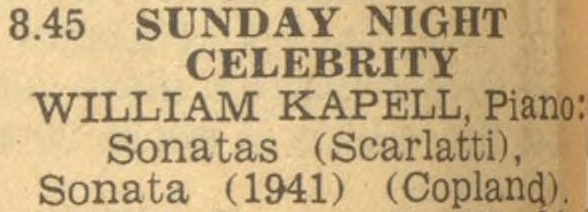
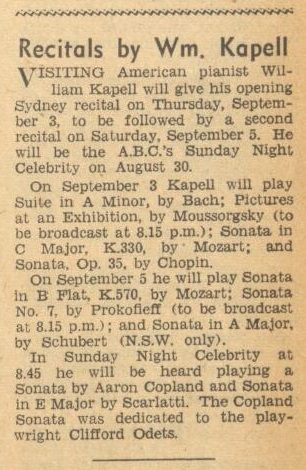
16- September 03 SYDNEY TOWN HALL Program n°1
BACH Suite BWV818 – MOUSSORGSKY Pictures at an Exhibition – MOZART Sonata K.330 – CHOPIN Sonata n°2 Op.35

Announcement of the concert / Broadcast of the 1st part of the concert
The Sydney Morning Herald (September 4): ‘Sentimental humbug was rigorously shut out from the keen, crisp performances given at the Town Hall last night by the American pianist, William Kapell, and a good deal of reputable sentiment and warm colour was shut out with it. His programme offered a double contrast between classics and romantics… Not often did Mr. Kapell let it be supposed that any of this music was more than shallowly exciting. It came from him, rather, as a somewhat cool, intellectual game, a disciplined exercise in the physics of tone. It was methodical. It was businesslike. Perhaps this extreme detachment of style is Mr Kapell’s reaction to too many earlier charges of « immaturity » – if so, it is a reaction that may prove fruitful in time. At all events, his vigilant efficiency as a technician was never in doubt last night, and there was vitality and interest in nearly all that his hands and mind « machined. » The Bach, a dry work, was played with dry composure until the final gigue, and that was assailed with unclassic harshness of weight and energy. The Mozart was elegant, decorative, impatient in the andante, generally impersonal and unsmiling. The Chopin, noisy early, became radiant for the funeral march, despite under-emphasis of the bass’s tread and dolor, and found uncommonly fateful beauty in the shuddering winds of the finale. Moussorgsky’s « Pictures, as usual, were a popular success, incisively witty in many places. The minstrel’s song might have been sweeter, Mr Schmuyle might have been more of a whimperer, Mr Goldenberg might have been fatter, the peasant’s weary oxen might have drudged along instead of boasting of their strength – but lighter interludes about the unhatched chickens and the Tuileries nursemaids were quite charming. Lindsey Browne
Daily Telegraph (September 4): ‘Think of the few great pianists you have heard and put the name of William Kapell beside them — for that is where it belongs. At the Town Hall last night, Kapell gave superb performances in the first of three recitals he is to give in this city. Glowing adjectives are inadequate to describe the beauty of his tone, the colossal magnitude of its size, his control of nuance, the delicacy of phrasing, the thought and sensitivity that colored everything he played. He gave to the music a most rare intensity, an emotional weight that gripped his audience and held them. And this in a programme chosen, surely, for the connoisseur. For a Bach Suite framed Moussorgsky’s « Pictures at An Exhibition » and Mozart’s C major sonata preceded the B flat minor Sonata of Chopin in the second half. Kapell’s interpretation of the Moussorgsky Pictures was something quite extraordinary in its startling vividness, its breathtaking power. And this was true also of the Chopin Sonata, where tenderness was always allied to strength and there was nothing to cloy the palate. It was Chopin on a truly hig scale a Chopin of noble power and proportions’. Eunice Gardiner
17- September 05 SYDNEY TOWN HALL Program n°2
MOZART Sonata K.570 – PROKOFIEV Sonata N°7 OP.83 – SCHUBERT Sonata A Major D.959

Announcement of the concert / Broadcast of the 1st part of the concert
The Mozart and Prokofiev sonatas have already been broadcast on July 25. So, ABC missed the opportunity of broadcasting nationwide the Schubert Sonata, new to Kapell’s repertoire.
The Sydney Morning Herald (September 7): ‘Pianist William Kapell had two outstanding successes at his Town Hall recital on Saturday night. One of them was perhaps inevitable, the other more unexpected. One of the works was Prokofiev’s Seventh Sonata, which is perfectly suited to Kapell’s muscular and forthright virtuosity, the other was Schubert’s great A Major Sonata, which one would have thought less suited to the rather hard-edged, black-and white style he revealed at his first recital. The quick movements of the Prokofiev made an exciting essay in pounding rhetoric, machine-like articulation, precipitous contrast, and driving impetus. It was grand fun, but it still could not prove that this later Prokofiev work is a great, rather than entertaining, piece of music. The slow movement, with its parody of a sentimental ballad tune, is hardly even entertaining. Kapell commanded attention throughout the 35-minute Schubert sonata with the breadth of his design and the surprising warmth of his sympathy. The work, with its wide range of emotional territory and the length of its periods, is not an easy one to keep under control. Once or twice a melody was brought rather too severely into relief where it should have been gently embraced by its accompaniment. But in general it was an engrossing performance of a too-little-known work. The recital opened with a Sonata in B Flat by Mozart, the slighter of the two familiar sonatas in that key. It was done with graceful, rather cool, efficiency, relieved by a deft touch of humour in the last movement. M.L.
Daily Telegraph (September 6): ‘American pianist William Kapell showed fine quality in his three-sonata recital at the Town Hall last night. The sonatas were very mature examples of each composer – Mozart B flat K.570, Prokofieff No. 7 and Schubert A major, one of three published as Schubert’s very last compositions. Kapell’s treatment of them was also very mature. He puts immense thought behind his music, plans it carefully and goes about it deliberately. Perhaps that is why Kapell presented the long-winded Schubert Sonata as purposeful music in which he had found poetic enjoyment. His Mozart was impeccable without being fussy – the last two movements at least – and had a perky vitality. But if anything had vitality, it was his powerful impression of the Prokofieff sonata. Kapell has come back to us as a pianist of some stature’. T.F.M.
18- September 08 NEWCASTLE CENTURY THEATRE BROADMEADOW
MOZART Sonate K331 – CHOPIN Sonate n°2 OP.35 – DEBUSSY Suite Bergamasque –SCHUBERT Impromptus Op.142 D.935 n° 1,2 – LISZT Hungarian Rhapsody n°11

Broadcast of the 2nd part of the concert
19- September 09 MAITLAND TOWN HALL
MENDELSSOHN 4 Songs Without Words – CHOPIN Barcarolle – Nocturne Op.55 – Scherzo n°1 Op.20 Waltz in E Flat
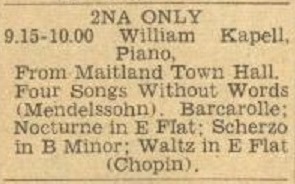
Broadcast of the 2nd part of the concert
19bis-Thursday September 10 « ANYTHING BUT JAZZ » presented by WILLIAM KAPELL
SYDNEY THE THEATRETTE BROADCAST HOUSE (ABC YOUTH CONCERT COMMITTEE)
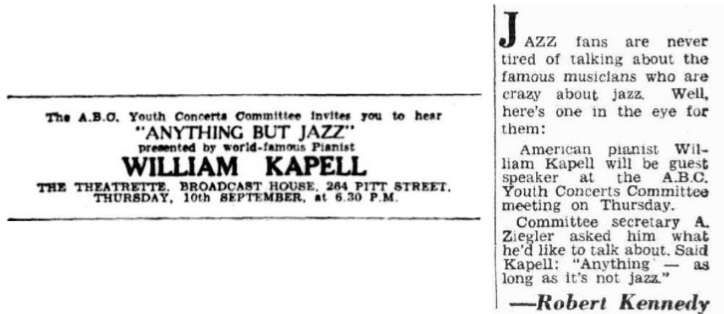
20- September 12 SYDNEY TOWN HALL Program n°3
SCARLATTI 4 Sonatas – COPLAND Sonata – DEBUSSY Suite Bergamasque – CHOPIN Barcarolle Op.60 -Nocturne Op.55 N°2 – Scherzo n°1 Op.20

Announcement of the concert / Broadcast of the 1st part of the concert
After having been told by the ABC presentation officer to do so, Kapell performed the US National Anthem before the ‘God save the Queen’, which led to a minor scandal, but the misundersanding was soon explained by ABC.
The Sydney Morning Herald (September 14): ‘The American pianist, William Kapell, gave a stylish performance of Debussy’s Suite Bergamasque at the Town Hall on Saturday, and he made out for Copland’s 1941 sonata just about as good a case as could ever be made for this dry, austere work. Mr. Kapell’s aggressive approach to four Scarlatti sonatas early, with tone as hard as New York asphalt and moods twitching like Times Square neon, must have left his audience quite unprepared for the antic elegance, the exquisite transparencies of texture, and the subtle tasting of vintage sensations in his Debussy playing….Mr. Kapell played Copland’s sonata incisively, with the air of stubborn defiance that suits its percussive chords, and he was careful not to let the work go soft during the bell ringer’s harmonies of the first movement. In a work that could easily seem scrappy and improvisatory, the pianist did well to find and preserve a firmly unified design’. Lindsey Browne
The Sun (Sept 13): ‘Kapell played an austere sonata of marked originality by Aaron Copland, and four tiny sonatas by Scarlatti, where the dryness of harpsichord tone was disturbingly absent’… In the second half, there was none of the emotional reticence that has been a feature of some of his recent playing in Sydney. Instead, there was warmth without gush and elegance without prettification. The last two items in Debussy’s Suite Bergamasque were enchanting studies in delicately weighed dynamics and cool phrasing. In the final Chopin group, Kapell showed himself to be a very fine pianist indeed. A masterly performance of the Barcarolle was followed by a movingly romantic Nocture in E Flat, Op.55. He finished his concert with an electrifying account of the B Minor Scherzo’. JBR
Of course, Browne’s remark about the Scarlatti Sonatas hurt Kapell. But, even before, tired and rather depressed, he thought of cancelling the remaining concerts, but he couldn’t in view of the considerable amount of money he would have had to refund, which means he had no choice but to give the 17 remaining concerts.

William KAPELL: I – Concerts n° 1 – 14 (JULY 18 – AUGUST 26)
MELBOURNE, ADELAIDE, PERTH, BRISBANE
TRIBUTE TO WILLIAM KAPELL: 70 years ago, William Kapell made his second Tour in Australia. The 37 concerts are listed for the first time. Here are the programs and reviews of concerts n°1 to 14.
After his successful summer concerts at the Prades Festival, William Kapell and his family returned to the United States and most immediatly, he left for Australia where he arrived on July 11 to give 37 concerts (38 were scheduled, but one was cancelled), namely 20 recitals and 17 concerts with various orchestras. For the recitals he prepared 3 ‘standard’ programs which he used for 10 of them, while the 10 other recitals had specific programs. He was also invited twice to play in the ABC Studios for a progam named ‘Sunday Night Celebrity’. Since the tour was organised by the Australian Broadcasting Corporation (ABC), many concerts were broadcast (for the recitals , it was only either the first or the second part), but ABC was legally binded not to keep recordings of the performances, and the live recordings that have been published come from recordings off the radio cut on 16’’, 33 rpm acetates by a single amateur from Melbourne, Mr. Roy Preston, using a device made in Melbourne, named ‘Royce Senior Recorder. In the concert list, published recordings are marked by a *.
The Kapell concerts broadcast nationwide on either 2FC-NA or 2BL-NC Radio stations are found on ABC Weekly, whereas concerts broadcast only on local Radio stations are listed on local newspapers, and are difficult to find.
Most of the concerts were announced and also reviewed in the local press everywhere in Australia, so that, with the information published in the newspapers of that period, we have been able for the first time to make a list of these concerts. For only a few of them, it has not been possible to find the program that was played.
Kapell already toured Australia eight years before, and most of the music critics have recollections of his earlier performances. He had mainly a reputation as a virtuoso, but he was in the middle of the change he was determined to undergo with a view to becoming recognized as a ‘serious’ pianist, firstly by his joining the Prades Festival thanks to his friend Eugene Istomin, which allowed him to perform more chamber music, and work with musicians of different styles such as Grumiaux and of course Casals, and secondly by further thinking about his playing and adding new ‘serious’ works (Mozart Sonata K331, Schubert Sonata D.959, Beethoven Sonata n°23) to expand his rather limited repertoire. At the end of the tour, recordings with Jascha Heifetz and Gregor Piatigorsky were planned, namely the first two Brahms Violin Sonatas and also Trios.
However, the introduction of new works seemed to be a slow and difficult process: if the Schubert Sonata was part of his ‘standard’ Program n°2, the Beethoven Sonata n°23 and Mozart’s K331 Sonata were not scheduled to be played in the largest Australian cities. With this tour, he expected to be recognized for his efforts, and always the perfectionnist, he drove himself rather hard.
For more information, please read the two reference books: Tim Page ‘William Kapell A Documentary Life History of the American Pianist’ University of Maryland (1992), and Stephen Downes ‘A Lasting Record’ HarperCollins (2013).
01- July 18 MELBOURNE Victorian SO dir: Joseph POST (1906 – 1972)
PROKOFIEV Concerto n°3 – FALLA Noches en los jardines de España
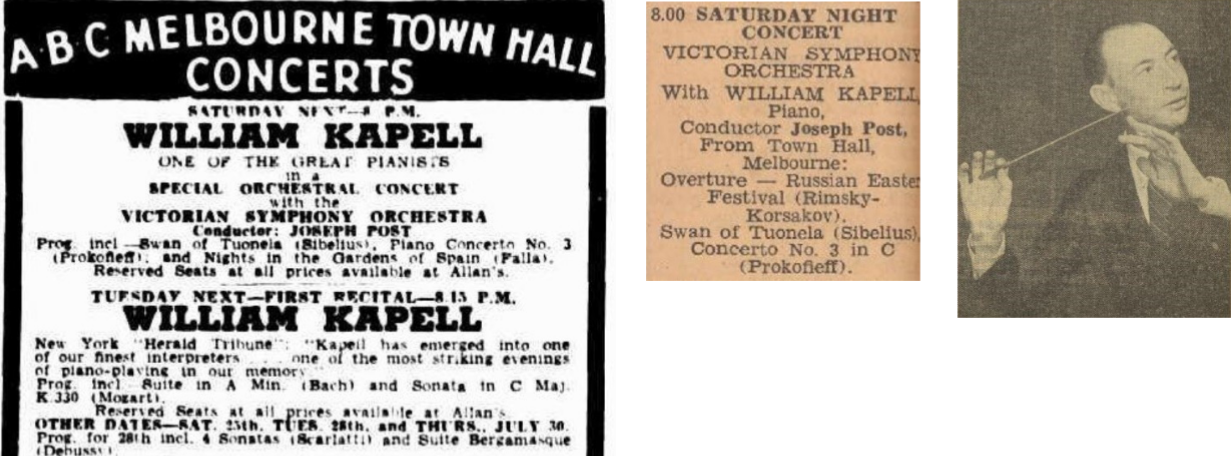
Announcement of the concert / Broadcast of the 1st part of the concert / Picture of Joseph Post
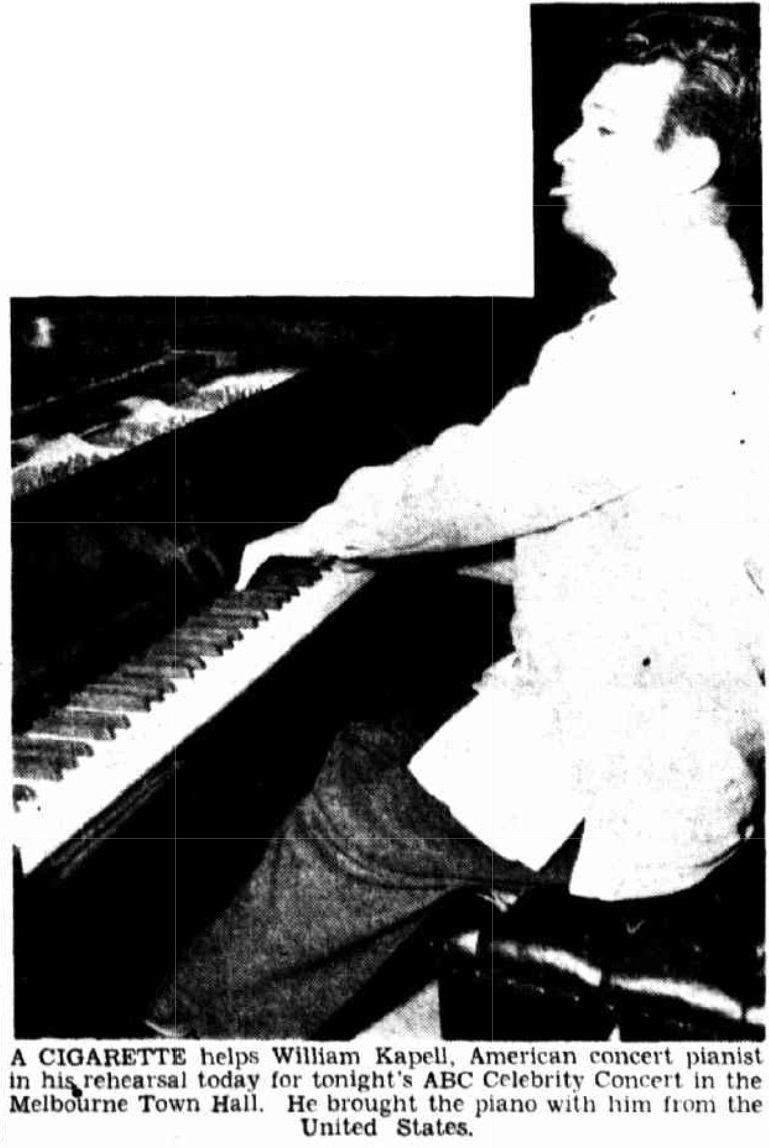
William Kapell rehearsing (July 18)
The Argus (July 20): ‘William Kapell is the first contemporary-minded pianist to tour Australia… Public interest in contemporary and near-contemporary music has reached an all-time high. Mr. Kapell’s superlative performance in Prokofiev’s third pianoforte concerto on Saturday night was both an object lesson in modern keyboard technique and an overdue corrective in the idea that ‘new’ music must be rowdy or sensational – or both. In the sense that few living pianists have William Kapell’s automatic command of muscular reflex, the performance was more than sensational – it was possibly unique. At no time however was there a suspicion of mere gymnastic clevernes. Only the result registered. A rapier flash of rhythm, tone of incandescent brightness, mastery of bizarre color – these essential elements in fine Prokofiev playing were superbly coordinated. Imaginative support by Joseph Post and the Victorian Symphony Orchestra completed an interpretation memorable for its note of sophisticated fantasy’. Biddy Allen
The Age (July 20): ‘Since his previous visit to Melbourne eight years ago, Mr. Kapell has gained maturity and authority. Prokofieff’s concerto, written before he returned to Russia, is a genial work notable for a freedom of expression that the composer was not always able to achieve in later years. The striking things in this interpretation were the excellent relation between soloist and orchestra, and the full flowing richness of sound that resulted from the collaboration. This was music bearing every indication that the intention of its creator was being met’.
02- July 21 MELBOURNE TOWN HALL Program n°1
*BACH Suite BWV818 – *MOUSSORGSKY Pictures at an Exhibition – MOZART Sonata K.330 – CHOPIN Sonata n°2 Op.35

Announcement of the concert / Broadcast of the 1st part of the concert
The Age (July 22): ‘American pianist, William Kapell, opened his season of four recitals in the Town Hall last night with a program which, even though it introduced nothing new, proved to be vital and interesting. Moussorgsky’s Pictures at an Exhibition had had a fairly good innings here from visiting local pianists and in the orchestral version. Last night’s audience could have be pardoned for thinking that there was little more to be got from it. But Mr. Kapell gave it something like a re-creation in one of the most arresting versions ever likely to come our way. Something more than brilliance went to its fashioning, and every picture was vividly alive and seeable. Equally compelling was the Kapell version of Chopin’s B Flat Minor Sonata (Funeral March) which, from the passionate and lyrical opening movements, gave us the well-known Funeral March in terms sombre and beautiful. Such a superb technician obviously likes to be busy. Maybe that is why his excursions into classicism were not so successful. His Bach Suite in A Minor was rhythmical and correct, and Mozart’s Sonata K330 somehow did not appear to be in the right company’.
03- July 25 MELBOURNE TOWN HALL Program n°2
*MOZART Sonata K.570 – *PROKOFIEV Sonata N°7 Op.83- SCHUBERT Sonata A Major D.959

Announcement of the concert / Broadcast of the 1st part of the concert
The Herald (July 27): ‘William Kapell, in his second recital in the Melbourne Town Hall on Saturday night, showed himself a pianist to be regarded with astonishment and considerable respect. Even for a critic who tends to be disinterested in executive brilliance, Mr. Kapell’s ability to deny the existence of technical difficulties is fascinating. And for those of us who are primarily interested in the real stuff of music, he had plenty to offer. It was impossible not to feel the driving intensity of his playing, the pressure exerted by the temperament of an uncommunly serious musician. Mr. Kapell is a too high-powered Mozart player for my taste. Yet, in the lovely B Flat Sonata, where a performer can so easily betray his superficiality, he was never found wanting. It was a finely cultivated playing, to say the least. If Schubert’s posthumous A Major Sonata fared less well, it was not that Mr. Kapell failed to approach the work with thoughtfulness and scholarship, but simply that Schubert demands a rather more relaxed and more lyrical style. The most exciting work of the program was Prokofeff’s Seventh Piano Sonata which was played with astonishing power and brilliance and with a shrewd and incisive sense of character’. John Sinclair
03bis- July 26 Sunday Night Celebrity (ABC Melbourne)
CHOPIN Sonata n°2 Op.35


04- July 28 MELBOURNE TOWN HALL Program n°3
SCARLATTI 4 Sonatas – COPLAND Sonata – *DEBUSSY Suite Bergamasque – *CHOPIN Barcarolle Op.60 – *Nocturne Op.55 N°2 – *Scherzo n°1 Op.20

Announcement of the concert / Broadcast of the 2nd part of the concert
Early in the tour, William Kapell arranged a meeting with Melbourne music critics in his suite at Menzies Hotel to play the Copland Sonata for them. Phillips, Dorian le Gallienne (The Age) and John Sinclair (The Herald) attended. All three were also composers. His wife Anne-Lou, who just arrived from New-York attended it, too.
The Advocate (August 6): ‘Between the exquisite perfection of Scarlatti’s craftmanship and the stark piano style of Aaron Copland, there can be imagined no wider contrast, yet Willam Kapell’s mastery enabled him to interpret each composer’s music with persuasion and authority. On Tuesday of last week, he began his piano recital with an indescribably fine performance of Four Scarlatti Sonatas followed by the modern piano sonata by the American Copland. The later work sounded harsh, unlovely, and at times uncertain, yet it had a certain power which Mr. Kapell’s incisive strength of tone and rhythm impressed on the listener. William Kapell’s interpretation of Debussy’s ‘Suite Bergamasque’ allowed the ear to revel in the delicacies of exotic chords and harmonies, while the imagination lingered over the subtle imagery expressed in the music. The playing of three works by Chopin Barcarolle Op.60, Nocturne in E Flat Op.55, and Scherzo in B Minor, were remarkable for the mastery of piano virtuosity and all tone colours and with their fire and poetry, these interpretations were worthy od one of the most expressive of all writers for the piano’.
July 30 MELBOURNE TOWN HALL [cancelled]
[BACH Partita n°4 BWV 828 – MENDELSSOHN 4 Songs Without Words – CHOPIN Sonata n°3]

Kapell was diagnosed ‘nervous exhaustion’ with muscular trouble in his back, shoulders, and upper arms, and he was obliged to cancel at the last minute. This was the only scheduled program with Bach’s Partita n°4, so it was not played during the tour. Happily, he recovered very quickly, in time for the first Adelaide recital two days later.
05- August 01 ADELAIDE TOWN HALL Program n°1
BACH Suite BWV818 – MOUSSORGSKY Pictures at an Exhibition – MOZART Sonata K.330 – CHOPIN Sonata n°2 Op.35
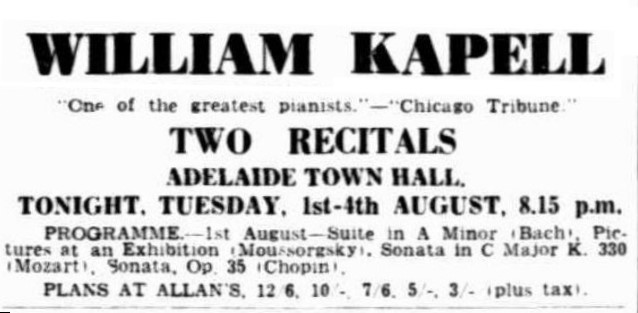
The Advertiser (August 3): ’In the Bach suite in A minor, a serene and lucid touch in the calm slow movements was hardened now and then with a trace of dynamic harshness and accentuation in the quick movements. For the massive chord passages of Moussorgsky’s ‘Pictures at an Exhibition’, the touch was clean, brilliant and powerful, and the sumptuous classic severity of the phrasing used in Bach was replaced by a rubato so personal that it might have seemed merely capricious if Mr. Kapell’s task and judgment had not made it sound musically right. Each of the little masterpieces of genre were played with a certain independence of tonal values and dynamic contrasts – the dynamic grading in ‘Bydlo’ for example and the climax splendidly made in ‘The Great Gate of Kiev’ – but a more brilliant and characteristic exposition cannot well be imagined. The scale of tone was right too for Mozart. In the sensitively played Sonata in C Major K.330, Mr. Kapell kept his playing within fairly narrow dynamic limits and was sparing with colors, but he invested his touch in the opening movement and the Andante with a kind of fresh natural bloom and for the Finale kept it clear and crystalline. The ‘Funeral March’ Sonata of Chopin was beautifully though not movingly played. Phrasing was as shapely as it was in Mozart, but here Mr. Kapell disclosed his range of touch from the singing quality untinged with sentimentality in the cantilena of the ‘Funeral March’ movement to the lissom, dry leggero in the weird Toccata-Finale’. Dr. Enid Robertson
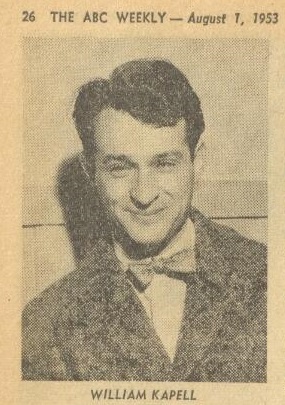
06- August 04 ADELAIDE TOWN HALL Program n°2
MOZART Sonata K.570 – PROKOFIEV Sonata N°7 Op.83 – SCHUBERT Sonata A Major D.959
The Advertiser (August 5): ‘Once again, at his second recital in the town hall last night, William Kapell made a sparely designed program of three Sonatas unsupported by lesser works continuously telling and absorbing. In works as conflicting as these three Sonatas by Mozart, Prokofiev and Schubert, he remained conspiruously master of his every fine shade and technique. As an artist, his approach to all three styles was also sympathetic and assured. He opened mildly with the deliberate and delicate grace of Mozart in a Sonata that hinted what Mozart might have achieved in this form had he lived long enough to develop its use of it more fully. For Mozart, externally deliberate perhaps, yet spiritually so elusive, the feeling was right and also the scale of tone. Mr. Kapell almost imperceptly lingers over and caresses with dulcet inflexion details which he plainly loves. In the slow movement, his pianissimo phrases were memorable and the sprightly Allegretto Finale he made vivacious and winsome. For the Prokofiev Sonata, an ashamedly dry ‘dog biscuit’ example of a notoriously ‘dry’ composer, he became a different pianist. The harsh bite to the opening of the Allegro Inquieto, the work’s brutal pianism, the Interlude of slightly commonplace lyricism in the slow movement, and the barren excitement of the Toccata-like Finale were disclosed with a ruthless, confident mastery which was exhilarating. The strength as well as the occasional weakness of Schubert appeared in the Sonata in A major, which Mr. Kapell played with affectionate warmth. In its authority, his treatment was also of the mind as well as of the heart. In the lyrical moments, he made the piano sing under his fingers. This and the significance of the pauses, the allusive touches reminiscent of Beethoven, and the articulate shaping of the phrases so as to retain significance of design throughout, made the performance ennobling and arresting. Dr. Enid Robertson
07 & 08- August 07-08 PERTH CAPITOL THEATRE
RACHMANINOV Concerto n°3 West Australian SO dir: Rudolf PEKAREK (1900 – 1974)
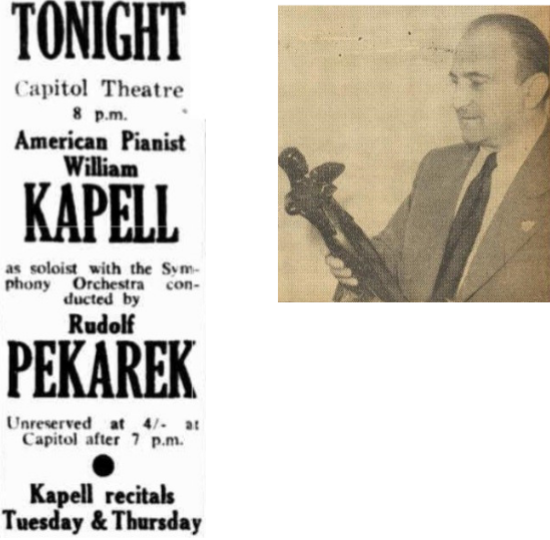
Announcement of the concert / Rudolf Pekarek
Sunday Times (August 9): ‘Nothing short of astonishing was last night’s performance of William Kapell. He played with the WA Symphony Orchestra at the Capitol. His was a performance of great beauty, tender in its phrasing, full of dazzling virtuosities and constrained to the tiniest details at the same time. Rachmaninoff’s floridly romantic style permeated with Russian lyricisms was fully evident in his magnificent Concerto no. 3. Kapell, the soloist, played it with dynamic effects as well as with moving warmth, never being too heavy or too brusque. He revealed all its gorgeous pianistic lines and heart melting romantic melodies impressing himself as a true virtuoso’. Dr B. V. Pusenzak
09- August 11 PERTH CAPITOL THEATRE
BACH Suite BWV 818 – MOZART Sonata A major n° K.331 – MOUSSORGSKY Pictures at an Exhibition – CHOPIN Barcarolle Op.60 – Nocturne Op.55 N°2 – Scherzo n°1 Op.20
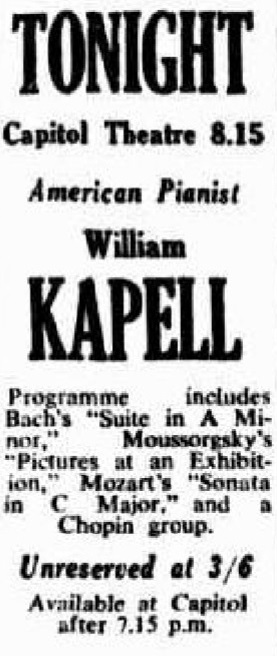
It was Kapell’s first performance of the A major Mozart Sonata. He performed it instead of the scheduled C Major Sonata K330.
The West Australian (August 12): ‘The poet who resides behind Mr. Kapell’s waistcoat and who was allowed by Rachmaninov No. 3 to peep out only briefly at the weekend, took full control at last night’s solo recital in the Capitol. My goodness! How that poet has grown in the seven years since Kapell played here last! Kapell has developed from a brilliant young man into an artist who is even more brilliant where brilliance is in place, but who now grips imagination and heart with grand performances of mature power and outstanding artistic integrity. From first to last, no matter whither the programme led, we had that deeply satisfying evidence of proportion and balance, exquisitely expressed, which is one mark of a first class artist. And we had a constant assurance that with Kapell the composer comes first, that the performer never stands, with mere effect-making, between the composer and ourselves. The several dances which make up the Suite in A Minor by Bach sounded not as a conventional gesture to an Old Master but freshly beautiful, an offering brought with love and understanding. A Mozart sonata likewise was made by Kapell’s fingers to cast a spell of unaffected appeal. The Moussorgsky « Pictures at an Exhibition, » not heard here for a long time, call for a palette of tonal colours over a great range, for pianism, at times, of the most sonorous power, for the gift of romantic and pictorial evocation in a variety of forms. We cannot recall a performance which measured up to all this so splendidly as did Mr.Kapell’s. The poet in Mr. Kapell, never out of the picture, was strongly in evidence in the final Chopin group – a poet of infinite delicacy in the E Flat Nocturne, a strong, passionate poet in the « Barcarolle » and in the Scherzo in B Minor. The Scherzo, particularly, was fierily superb, with a lovely dream at its heart. In short, Mr. Kapell has become an artist whom we must place among the outstanding pianists of our experience over many years. ‘Fidelio’
10- August 13 PERTH CAPITOL THEATRE
SCARLATTI 4 Sonatas – CHOPIN Sonata n°2 Op.35 – DEBUSSY Suite Bergamasque – SCHUBERT 2 Impromptus – LISZT Hungarian Rapsody n°11
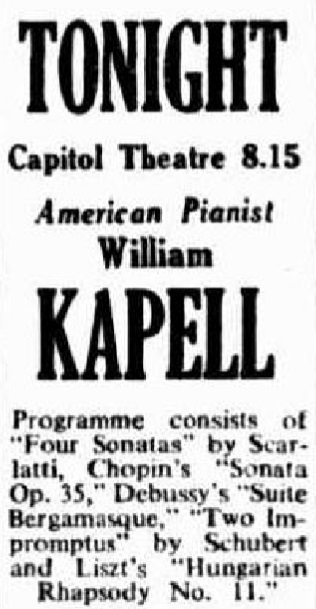
The West Australian (August 14): ’From his first to his last note, William Kapell swept us along with him again last night on his superb artistry. His is the sort of piano-playing which brings a work directly and freshly to the listener, stimulating and compelling him to enter into the life of the music. Last night we had such dissimilar composers as Scarlatti, Chopin, Debussy, Schubert and Liszt; yet each work was presented in perfect style and shape. With this comprehensive understanding and sensibility, Kapell combines a wonderful technique which is so controlled and undemonstrative that he can make the most brilliant virtuoso passages look deceptively easy. This was the case in the scintillating Scarlatti sonatas, executed with great precision and sparkling fluency, and in the seldom-heard Hungarian Rhapsody No. II, a typical Liszt composition of bravura passages and exciting climaxes. Rarely does an artist have such a range of tonal colourings at his command as that which Kapell showed us in his performance of Debussy’s Suite Bergamasque, a work of shimmering patterns and charming piquancy. And rarely do we hear Chopin’s Sonata in B flat minor played with such whirlwind brilliance and exquisite delicacy, and with such a simple singing tone in the lyrical passages. It is a long while since we have heard such fine work’. P.K.
11- August 17 BALLARAT BRITTANIA THEATRE (MOZART SONATA K.331?)
12 & 13- August 21,22 BRISBANE CITY HALL Queensland SO dir: Joseph POST
BEETHOVEN Fidelio Ouv. – BRAHMS Concerto n°1 Op.15 – HINDEMITH Mathis der Maler
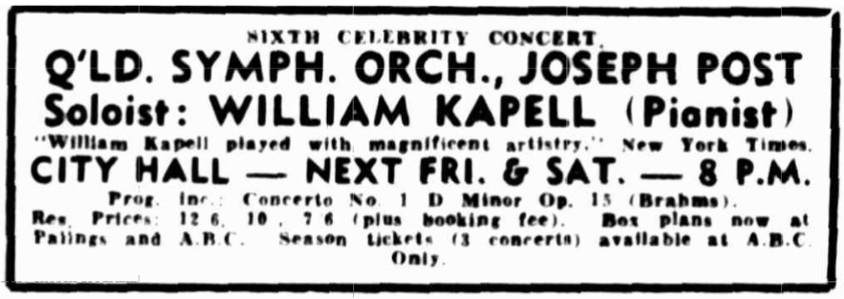
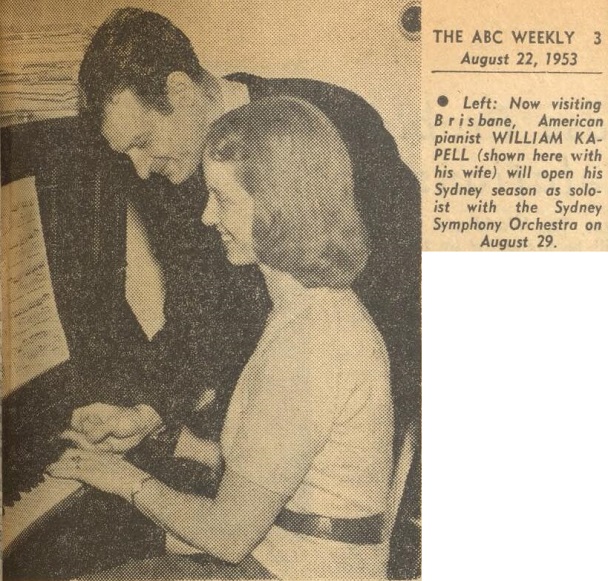
14- August 26 BRISBANE CITY HALL Program n°1
BACH Suite BWV818 – MOUSSORGSKY Pictures at an Exhibition – MOZART Sonata K.330 – CHOPIN Sonata n°2 Op.35

Announcement of the concert / Broadcast of the Chopin Sonata n°2
The Courier Mail (August 27): ‘An enthusiastic audience greeted William Kapell at his pianoforte recital in the City Hall last night under the auspices of the ABC. Mr. Kapell fully deserved the tributes paid to him, for I feel that he is one of the finest pianists whom we have yet heard in the City Hall. He has an uncanny capacity for adapting himself to the period and style of each composer whom he plays, so that his Bach gave a suggestion of the harpsichord for which the music was written. His Moussorgsky was full-blooded, and a little rough and uncouth; his Mozart smooth and polished with just the right touch of sentiment; while his Chopin gave him full scope for emotional playing. Opening with the A Minor Suite of Bach, his vigorous, incisive style at once set the atmosphere of the whole work, and his keen rhythmic sense made all the movements most compelling. Contrasting with the Bach, Moussorgsky’s ‘Pictures from an Exhibition’ enabled the player to produce all possible variety of tone and touch from the piano and to demonstrate that for him difficulties are non-existent. The Mozart Sonata in C major brought back memories of my own attempts in my student days, and my early realisation of the intense difficulty of playing Mozart in such a manner as to make every note occupy its exact place in the rhythmic and dynamic scheme. This was entrancingly beautiful. Kapell concluded the recital with a performance of the Chopin Sonata in B Flat minor, which includes the famous Funeral March, in a manner which was a veritable tour de force. It is to be regretted that he is not to be heard again in Brisbane’. Robert Dalley-Scarlett
Since one half of each of the three Melbourne recitals has been recorded (Kapell Rediscovered – RCA), this allows us to make our own opinion.
After a little more than one month of touring, William Kapell was not very happy with either the public ( there were often empty seats in the halls) or the music critics, but he was not prepared for what expected him with the further concerts in Sydney.
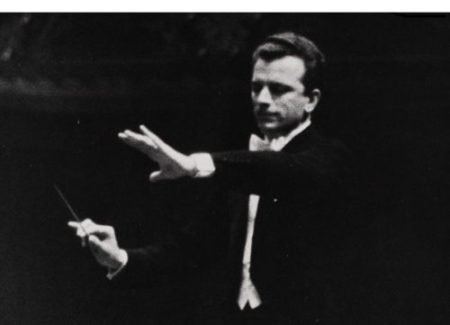
Guido Cantelli – Beethoven
Concerto n°3 Op.37 – Rudolf Firkušný, piano (Steinway) NYPO
Carnegie Hall – March 13, 1955
__________
Symphony n°1 Op. 21 – NBC SO
Carnegie Hall – January 10, 1954
Source: Bande/Tape 19 cm/s / 7.5 ips
Au cours des années cinquante, Firkušný était invité tous les ans à jouer avec le NYPO. En 1955, le choix se porta sur ce concerto de Beethoven, sous la direction de Cantelli. Les critiques du concert du 10 mars ont souligné la qualité de l’interprétation et l’entente entre le soliste et le chef.
Musical America: M. Firkušný et le chef d’orchestre étaient en parfait accord, ce qui a donné lieu à une interprétation bien intégrée. Bien qu’il ait semblé tendu, le pianiste a joué avec sa maîtrise technique habituelle et son tempérament sensible. Le soliste et l’orchestre ont apporté la même éloquence à la musique ».
New York Times: Dans le concerto de Beethoven, M. Cantelli s’est révélé être le plus sympathique et le plus attentif des accompagnateurs. Il a très bien travaillé avec M. Firkušný, et c’était un plaisir d’écouter les attaques et les relâchements tranchants. Le pianiste a joué magnifiquement, en prodiguant des détails d’écriture, en épurant ses phrases et en exécutant l’écriture avec netteté. Ce fut une interprétation élégante de la part de tous les participants, qui a fait ressortir la force et la poésie de la musique sans jamais commettre l’erreur de concevoir le Concerto en do mineur comme l' »Empereur ».
Cantelli a très peu dirigé la Première Symphonie de Beethoven. Son interprétation avec le NBC SO est une réussite et la source utilisée (une bande magnétique) est meilleure que celles des éditions précédentes.
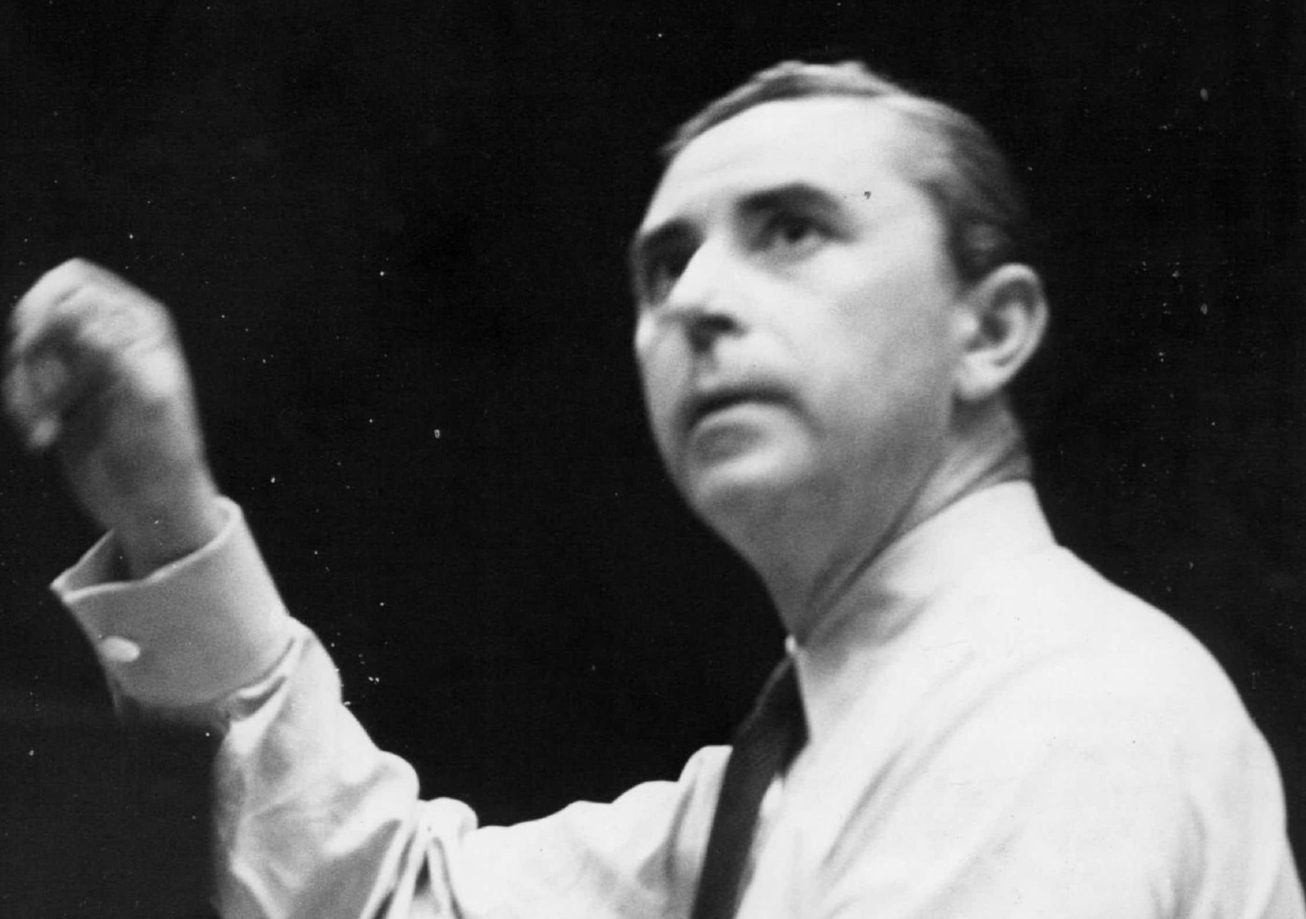
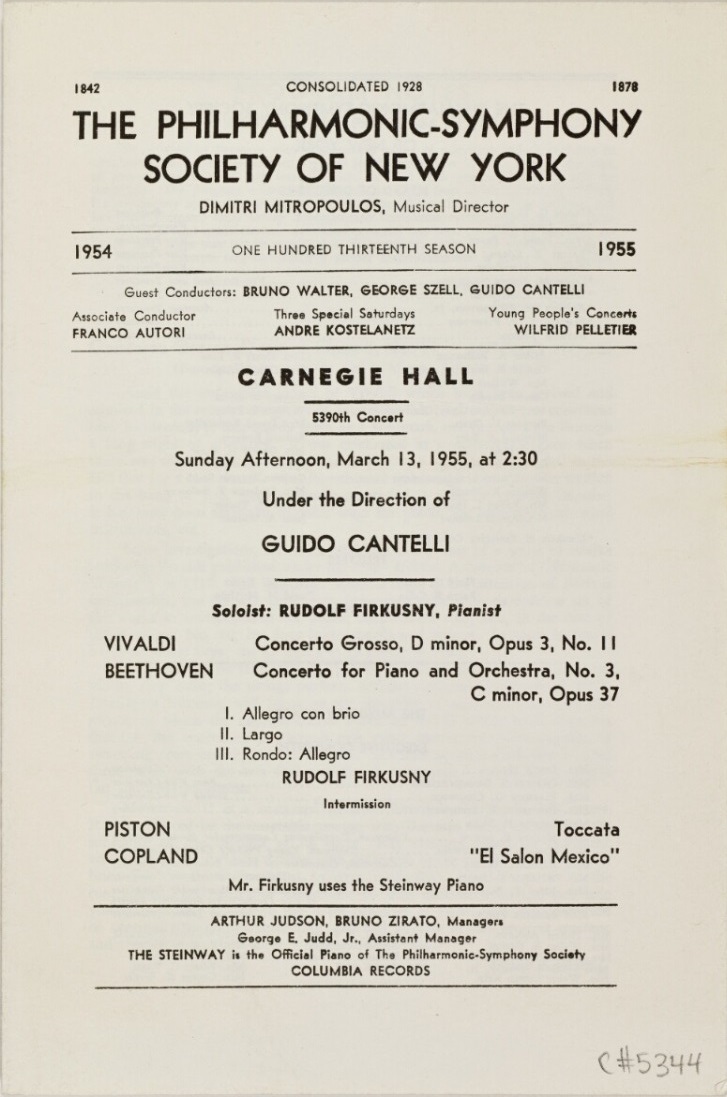
During the 1950s, Firkušný was invited every year to play with the NYPO. In 1955, the choice fell on this Beethoven concerto, conducted by Cantelli. Reviews of the March 10 concert praised the quality of the interpretation and the understanding between soloist and conductor.
Musical America: ‘Mr. Firkušný and the conductor saw eye to eye, and the result was a well-integrated performance. Although he seemed tense, the pianist played with his accustomed technical mastery and sensitivity of temperament. Soloist and orchestra brought equal eloquence to the music’.
New York Times: ‘In the Beethoven concerto, Mr. Cantelli proved to be the most sympathetic and careful of accompanists. He worked exceedingly well with Mr. Firkušný, and it was a pleasure to listen to the sharp attacks and releases. The pianist played beautifully, lavishing detail upon the writing, purling his phrases, bringing clean-cut execution of the writing. It was an elegant performance from all concerned, one that brought out the strength and poetry of the music without ever making the mistake of conceiving the C minor Concerto as the ‘Emperor’ ‘.
Cantelli has rarely conducted Beethoven’s First Symphony. His performance with the NBC SO is a success, and the source used (a magnetic tape) is better than those for previous editions.
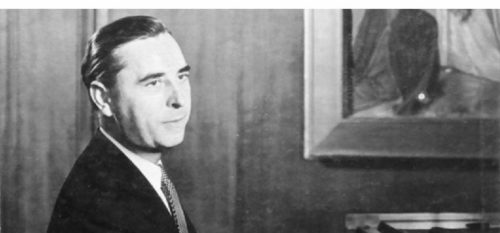
Rudolf Firkušný, piano (Steinway) – Guido Cantelli – New York Philharmonic (NYPO)
Carnegie Hall – April 8, 1956
Source: Bande/Tape 19 cm/s / 7.5 ips
Cette très belle interprétation du Premier Concerto de Brahms provient du dernier concert de Guido Cantelli à New-York.
Le pianiste avait beaucoup d’affinités avec le chef, ainsi qu’il l’a relaté dans une interview:
‘Cantelli était toujours extrêmement bien préparé et dirigeait la plupart des œuvres du répertoire de mémoire. J’ai eu énormément de plaisir à travailler avec lui, car nous avons ressenti une certaine affinité dans nos idées musicales. De plus, sa préparation scrupuleuse de l’orchestre rendait la coopération tout à fait idéale. Les concerts ne pouvaient que bien se passer après sa préparation minutieuse lors des répétitions. Bien qu’il soit exigeant et jeune, il était très respecté par les membres de l’orchestre et, je pense, très apprécié en tant que personne. J’ai été étonné par son évolution régulière et son processus de maturation. Notre dernière prestation a montré que son attitude à l’égard de l’orchestre s’était quelque peu adoucie, sans pour autant faire de concessions sur le plan des exigences’.
Les propos de Firkušný se reflètent bien dans des critiques de cette interprétation parues à l’époque:
Louis Biancolli (World Telegram and Sun) : ‘Avec Guido Cantelli dirigeant l’un de ses meilleurs accompagnements à ce jour, l’interprétation a été passionnante, depuis la force tragique et sinistre des accords d’ouverture jusqu’à la dernière explosion jubilatoire du Finale. M. Firkušný était dans une veine exaltante. Il a apporté une vigueur saisissante aux passages héroïques, donnant à la ligne soliste l’avantage d’un son fort et solide qui n’a jamais perdu de sa résonance. Dans les moments calmes également, il s’est montré un véritable poète, mêlant sonorités douces et sentiments tendres, inscrivant des phrases plutôt que des vers et laissant le plaisir de lire – et de penser – librement entre les lignes……. Depuis dix-huit ans que j’entends M. Firkušný jouer, je l’ai vu devenir l’une des personnalités les plus marquantes du clavier. Cette personnalité n’a jamais été aussi imposante qu’hier soir. Par leur tempérament et leur style, le concerto et M. Firkušný semblent avoir été conçus l’un pour l’autre, tant l’unité de la vision poétique est étroite.’
Howard Taubman (New York Times) : Rudolf Firkušný a donné un coup de fouet au concert philharmonique donné hier soir au Carnegie Hall avec une interprétation passionnante du Concerto en ré mineur de Brahms. Pianiste de tempérament, il a apporté poésie et tension dramatique à une œuvre qui exige un mélange de tendresse et de passion.
Il est aujourd’hui un pianiste majeur, l’un des meilleurs de la profession. Son interprétation de Brahms hier soir en est une nouvelle preuve. Il l’a fait dans la grande tradition. Dans le premier mouvement, qui est un drame puissant en soi, M. Firkušný a joué avec une profondeur et une solidité de ton, avec une compréhension de l’idiome romantique particulier de Brahms et avec une vitalité qui a parcouru toute son interprétation. Et même, à un moment donné, une série d’accords fortissimo était d’une intensité presque choquante. Mais le charme n’a pas été rompu : c’est comme si le pianiste secouait l’orchestre et le public pour les amener à un rapport plus concentré.
Guido Cantelli, qui entamait sa dernière semaine en tant que chef invité, a bénéficié d’un bien meilleur accompagnement de la part de l’orchestre que lorsqu’il avait fait appel cette saison, à deux reprises, à des pianistes solistes. Le mouvement lent, avec son chant soutenu et méditatif, était particulièrement envoûtant, et M. Firkušný s’y est montré un poète sensible, jouant avec une grande richesse de nuances.
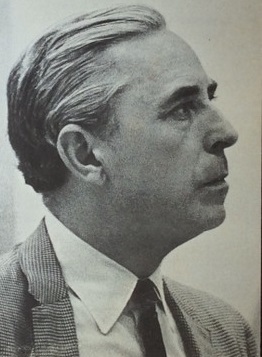
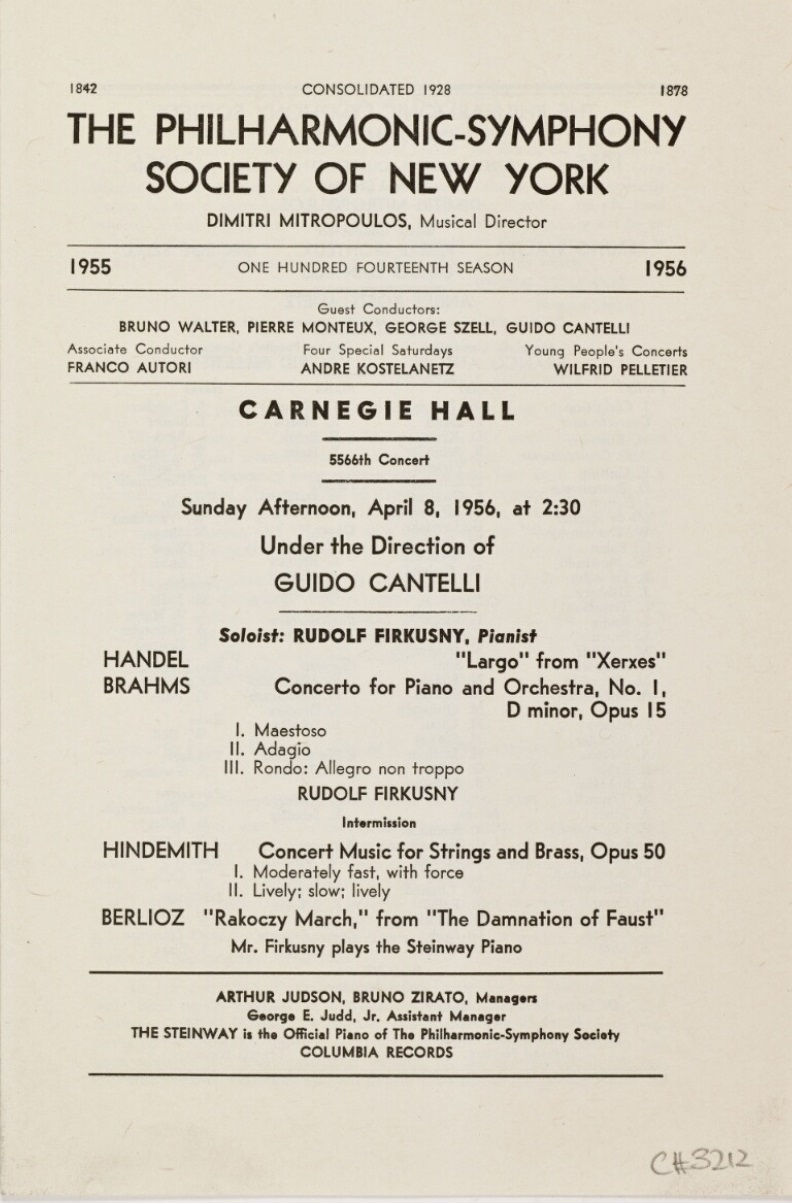
This beautiful performance of Brahms’ First Piano Concerto comes from Guido Cantelli’s last concert in New York.
The pianist had a great affinity with the conductor, as he recounted in an interview:
‘Cantelli was always extremely well prepared, conducting most of the standard repertoire from memory. I enjoyed working with him enormously as we felt a certain affinity in our musical ideas. Also, his scrupulous preparation of the orchestra made the cooperation quite ideal. The performances had to go well after his careful preparation in rehearsals. Although he was demanding and young, he was greatly respected by the orchestra members and I think very much liked as a person. I was amazed by his steady growth and maturing process. Our last performance showed that his attitude towards the orchestra had mellowed somewhat, yet without any concessions in his demands’.
Firkušný’s words are well reflected in reviews of this interpretation published at the time:
Louis Biancolli (World Telegram and Sun): ‘With Guido Cantelli conducting one of his finest accompaniments to date, the performance was a stirring one from the grim tragic strength of the opening chords to the jubilant last flourish of the Finale. Mr. Firkušný was in exalted vein. He brought arresting vigour to the heroic passages, giving the solo line the benefit of a strong, solid tone that never lost resonance. Also in the quiet places he was the true poet, mixing soft-spun sound with tender feeling, inscribing phrases instead of verses and allowing one the pleasure of reading – and thinking – freely between the lines…… In the eighteen years I have heard Mr. Firkušný play, I have watched il grow into one of the most commanding personalities of the keyboard. That personality was never so commanding as it was last night. In temperament and style, the Concerto and Mr. Firkušný seemed to have been intended for one another, so close was the unity of poetic vision.
Howard Taubman (New York Times): ‘Rudolf Firkušný gave a lift to the last night’s Philharmonic concert given at Carnegie Hall with an exciting performance of Brahms’ D minor Concerto. He is a pianist of temperament, and he brought poetry and dramatic tension to a work that demands a commingling of tenderness and passion.
He is now a major pianist, one of the best in the profession. His performance of Brahms last night was further evidence of this. It was in the grand manner. In the first movement, which is a powerful drama in itself, Mr. Firkušný played with depth and solidity of tone, with a grasp of Brahms’ special romantic idiom and with a vitality that pulsed through his entire interpretation. Indeed, at one point, a series of fortissimo chords was almost schocking in its intensity. But, the spell was not brocken: it is as if the pianist were jolting orchestra and audience into more concentrated rapport.
Guido Cantelli, who began his final week as guest conductor, got a much better accompaniment from the orchestra than he had on two previous occasions this season when he had piano soloists. The slow movement, with its sustained, meditative song was especially enamoring, and here Mr. Firkusny was the sensitive poet, playing with a wealth of nuance.’


